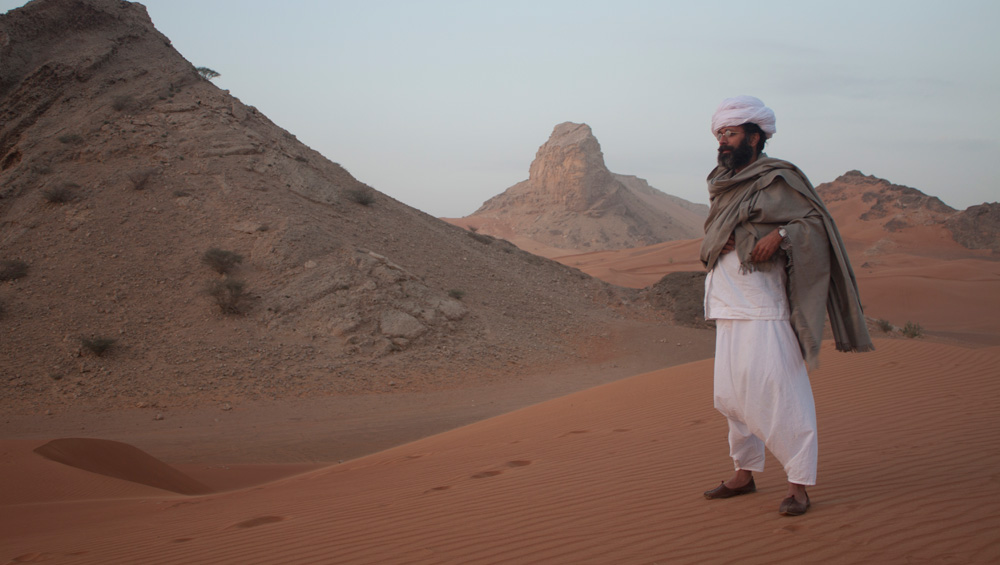
by SKYE ARUNDHATI THOMAS
I first met the Kolkata-born performance artist and painter Nikhil Chopra in Goa, in his old Portuguese house with its yellow-painted facade and seashell mosaics for windowpanes. At the entrance was a fine charcoal drawing of a sitar player in the throes of a song: eyes closed, one hand turned up in an elegant twist. He seemed to reflect the predilections of his maker, also an artist of immersive, dedicated performance.
One of Chopra’s children, Om, was making love potions in the kitchen and distilling them into tall, plastic flutes. We sat at the kitchen table, drinking potion, and looking through images of Chopra’s Documenta 14 performances, from which he had recently returned. Chopra had travelled along a 3,000 km route from Athens to Kassel with a camping van, a tent, cameras and supplies for making drawings. Madhavi Gore, an artist (and Chopra’s wife), extensively documented the trip. She writes: “When seen from a distance, there is a constant glow within the tent as if it has a warm light switched on.”

Nikhil Chopra. Drawing a Line through Landscape, 2017. Commissioned by documenta 14. Costume Design Loise Braganza. Photography Madhavi Gore. Image courtesy the artist, Chatterjee & Lal, Mumbai and GALLERIA CONTINUA, San Gimignano / Les Moulins / Beijing / Havana.
Their house struck me as having the same quality. Until a year ago, Chopra and Gore ran one of India’s only performance art residencies, the Heritage Hotel Art Spaces, first out of a small colonial hotel in Goa and then in a sprawling bungalow from the garden of which snakes lazily slinked in. Theirs is a practice of home, of community and of savouring shared moments and conversations.

Nikhil Chopra. Drawing a Line through Landscape, 2017. Commissioned by documenta 14. Costume Design Loise Braganza. Photography Madhavi Gore. Image courtesy the artist, Chatterjee & Lal, Mumbai and GALLERIA CONTINUA, San Gimignano / Les Moulins / Beijing / Havana.
Chopra’s performances are characterised by the same quality: he gets dressed slowly and carefully, applies kajal, and eventually moves towards the walls of a space to begin his drawings. Sometimes, he takes naps. His audience is important to him, as is their sustained attention: his performances are durational and site specific. His figurative work – paintings, watercolours, charcoal and ink drawings – is layered with a criticality, often of the postcolonial context. He is a kind of soft historian, a historian of experience, feeling and mood; of the histories that never made it into history books. He excavates spaces in order to find their deeper stories, as he will do as artist in residence at New York’s Metropolitan Museum of Art this September. Chopra will live in the museum for nine days as part of a performance entitled Lands, Waters and Skies (2019), moving through its rooms and interacting with its collection. Chopra is sharply cognisant of his place in the art world, and of the privileges his practice affords, which is something we returned to in the conversation below, about two years after that early monsoon afternoon at his home.
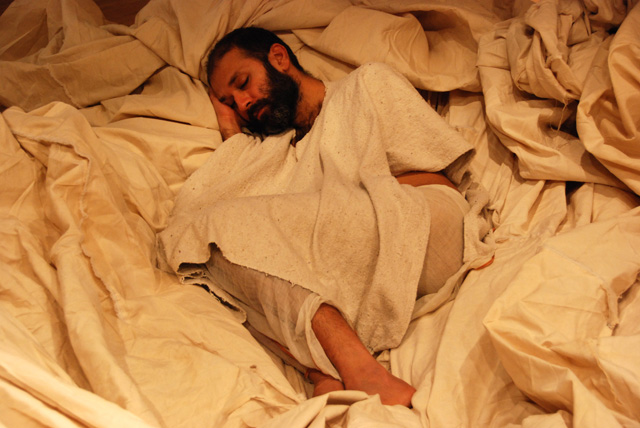
Nikhil Chopra. Coal on Cotton, 2013. Commissioned by Manchester International Festival and the Whitworth Gallery, Manchester. Costume Design Sabine Pfisterer. Photograph: Sabine Pfisterer. Image courtesy the artist.
Skye Arundhati Thomas: I am interested in what happens when you enter a museum with a colonial history, or the objects of colonial history, and introduce a critique of empire with your performance and work. Coal on Cotton (2013), at the Whitworth Art Gallery in Manchester, comes to mind, where you reflected on the labour relations between Manchester and Mumbai. Will you take the same approach for your performance at the Metropolitan Museum of Art later this year?
Nikhil Chopra: I think this is what is generally asked of me, as an artist, when I enter a museum or institutional space: to think of its position critically and to not be afraid of asking some very difficult questions. In every performance, I give myself a certain set of unknowns. I then use my performance to work out the unknowns. They are usually around identity, the body, politics and history. The labour is also the work: I like to show the slow unravelling of my process. A lot of my imagery comes from a colonised mind, as I come from a colonial history, which is the history of the subcontinent I am from.
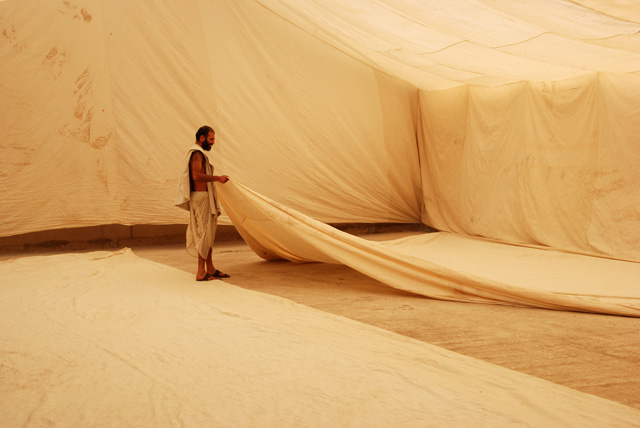
Nikhil Chopra. Coal on Cotton, 2013. Commissioned by Manchester International Festival and the Whitworth Gallery, Manchester. Costume Design Sabine Pfisterer. Photograph: Sabine Pfisterer. Image courtesy the artist.
At the Met, I am finding it hard to run away from the fact that while I am in, say, the Egyptology department in front of the Temple of Dendur – looking at this incredible piece of architecture of faith and belief, which has travelled all the way from the banks of the Nile in southern Egypt – I am thinking about how this ends up at a museum in New York City. Objects that travel in this way raise questions over how ownership is exercised over them, and how meaning is created in their display. It is also about how we place ourselves in that context: caught somewhere in between the past and the present. As a consumer, as a tourist, just like the millions of people who come to the Met to consume this building and these objects, I am approaching this project with my colonised brain to understand the dynamic this museum has set up with its audience, and the objects it owns.
SAT: Is it your intention to read these objects in a new way?
NC: The intention is not just to reread them: but to somehow rewear them and reuse them. I don’t mean that I am going to literally pull the objects out from their vitrines, but a lot of the objects I will use in my performance are going to reference things kept inside the vitrines. For instance, the linen I will use to make my dwelling – because I intend to inhabit the museum – is going to be reminiscent of Egypt’s history with the textile. There will be masks in my performance, or costumes that I am going to weave, all of which are going to reflect on certain objects in the museum. I also want to rethinkthe meaning of these objects. I look at the masks sitting inside the vitrines and ask, how many generations of stories are encased in these masks. What happened to the breath that was breathed into the back of the masks? These are the deep histories that are erased when precious objects get removed from their contexts and placed inside display cabinets, vacuum-packed and sealed off from the world that they once used to inhabit. I guess I am hoping to breathe into those masks again!
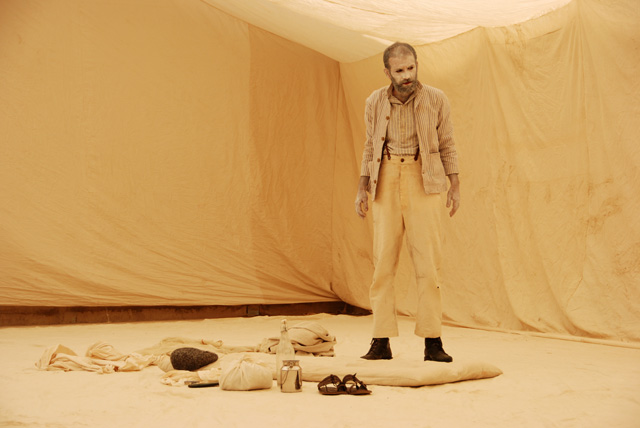
Nikhil Chopra. Coal on Cotton, 2013. Commissioned by Manchester International Festival and the Whitworth Gallery, Manchester. Costume Design Sabine Pfisterer. Photograph: Sabine Pfisterer. Image courtesy the artist.
SAT: Museums are often places of contradictory feelings for us – especially those of us from previously colonised nations – both a place of intrigue and of a kind of rebuke, a cruel reminder of the ownerships exercised over subaltern histories. They are difficult spaces.
NC: But these museums can also be spellbinding: there is so much power in the objects. There is, of course, a very particular power dynamic in the viewer’s relationship to the vitrine. It’s not just about trauma and blood, but also a deep regard for how beautifully and carefully they were made. In the digital age, it’s incredible to see a piece of hand-beaten gold turned into a mask, having travelled all the way from South America. I can’t help but think about South American immigrants, with their New Yorker IDs, coming into the Met and looking up at gold worth millions of dollars on display, so far away from their home country.
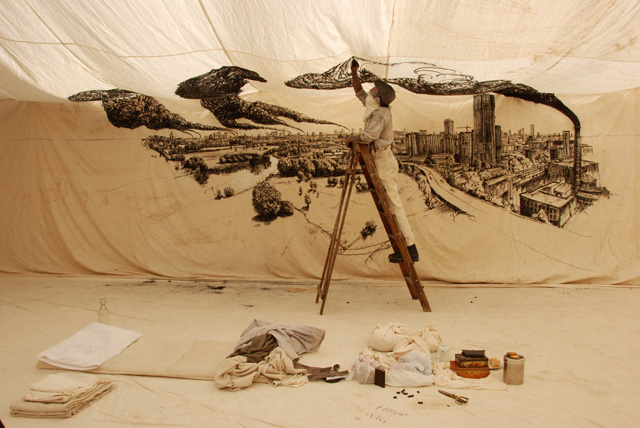
Nikhil Chopra. Coal on Cotton, 2013. Commissioned by Manchester International Festival and the Whitworth Gallery, Manchester. Costume Design Sabine Pfisterer. Photograph: Sabine Pfisterer. Image courtesy the artist.
SAT: I like the phrases you use – to reuse, rewear and rethink about the objects. Are these acts of decolonisation, of a kind of protest?
NC: They are definitely decolonial acts. But I also want to think about the US with a certain sense of poetry. I want to think about how this nation state’s history has taught us how powerful poetic voices are in countering oppression. I want to think through the history of jazz and the voice of Nina Simone and the African American history of rock’n’roll. It is a country of cultural revolutions. I don’t want to be in reverence of the US, but I want to revere and recognise its irreverent voices. I want to respect and engage with the space that culture has occupied for dissent. I have had a six-year-long relationship with the US because I lived there and studied there. My methodology and the ways in which I approach critical thinking are very American; the result of an American education and the globalised export of Americana. So, while I am colonised, I am also imperialised – to have thought that a US education was the one to aspire to, and to achieve. Now I am happy that there is a space for critical thinking within that, space to re-enter the context and reconsider my relationship to this place.
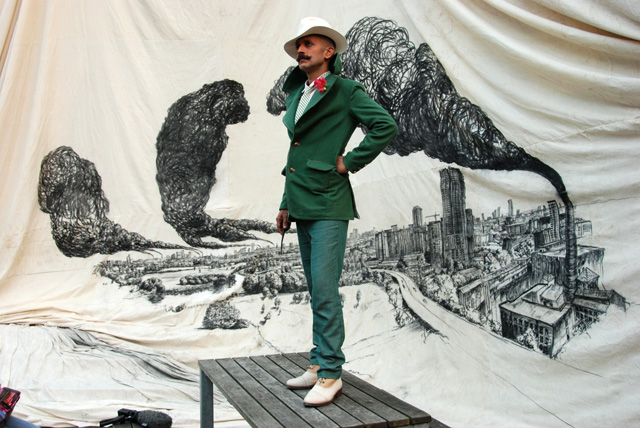
Nikhil Chopra. Coal on Cotton, 2013. Commissioned by Manchester International Festival and the Whitworth Gallery, Manchester. Costume Design Sabine Pfisterer. Photograph: Sabine Pfisterer. Image courtesy the artist.
SAT: The museum space gives you historic and material reference points to work through, or be in conversation with, but even when you have performed in warehouses, in emptier spaces, or so-called white cubes, you are still able to draw on historical references. Does it matter where you perform?
NC: I find white cubes very difficult. I don’t think that they exist; I am not convinced by the premise. Behind that white veneer, I think, is actually a lot of history and nuance. There are the bricks and mortar – and there are the street and neighbourhood just outside it. The city informs the space. I can’t just enter a space and take its whiteness at face value. I always want to move past this neutrality, or rather this posed neutrality. This is my thing: I like to walk into a space and not just be looking at it, but trying to look through it, to look past it. A lot of my early performances were about making the walls of the space disappear by painting on them so that you can feel as if you are looking through the walls. In the end, there is almost no difference between a white cube and a museum such as the Met: because they both have different contexts and histories to deal with. One just tries to hide it a little better than the other. I think the risks I take, and the shape that the work takes, all come out of the constraints of space, so I approach every space with the same kind of openness to discover what’s possible.
SAT: If you really think about it, museums have the same kind of pose towards neutrality as a white cube. A kind of history-making operation that tries not to pick a side or, to be more specific, doesn’t implicate itself in the histories it displays, as it often should.
NC: Yes, exactly. It’s a whitewash. The neutrality is imposed.
SAT: Your recent show at Chatterjee & Lal in Mumbai showed paintings and drawings from the Kashmiri valleys that your grandfather, a painter, also travelled through. You have performed, too, as “Yog Raj Chitrakar”, a painter from his time whom you describe going “on expeditions as an explorer making chronicles of the world. He uses drawing as a tool to make documents.” I am fascinating by this kind of document-making. For Documenta 14, you travelled across Europe, and the travel itself became a document. Is the document-making a kind of history-making project?
NC: Well, it is at first an art project. I want to give the artist as much importance as a scientist, as a journalist, as a historian. As an artist, I try to hold a mirror up to the world and capture what is being reflected in the mirror. Our eyes, ears, nose, mouth, stomach, legs, bum are the filters and the materials that we use to experience history. History is of the body. And all of these are informing and becoming the material through which these “documents” are being made – they are not textual documents, they are visual documents – and it is not necessarily always about what is in front of me, but maybe what I am looking at conceptually. I go out there seeking the stories. The reason I say “reflecting the world” is because I do want to give my work site-specificity, and I want to have relationship with place. I want to have a powerful relationship with single moments, with people and with audiences.
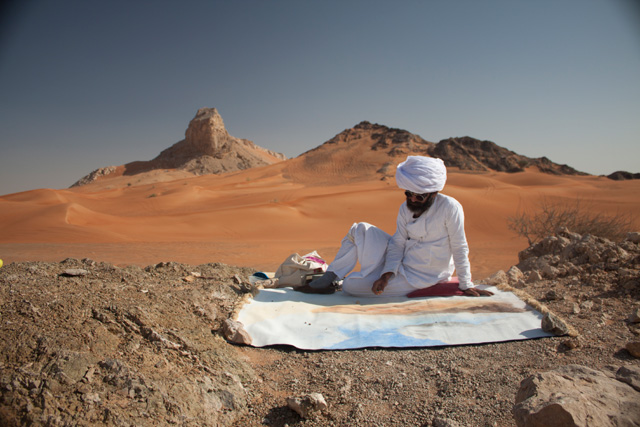
Nikhil Chopra. Use Like Water, 2013. Commissioned by the 12th Sharjah Biennale. Costume Design by Loise Braganza. Photograph: Istabraq Kinda. Image courtesy the artist, Chatterjee & Lal, Mumbai and GALLERIA CONTINUA, San Gimignano / Les Moulins / Beijing / Havana.
It is also important to make notations – to tag a wall or speak into a mic, or to annotate a moment in time. It is a way to allow for the body to enter the work. Documents are not always object-oriented – the brain is an incredible hard drive – and a lot of documents are in my memory, in your memory. They can be totally ephemeral. And that is a quality I like to reflect in my work, where every drawing is ephemeral. The museum creates a fetish around the object, but I am interested instead in holding on to moments, where the paintings are documents of those moments. I don’t want to put art in the romantic glass vitrine, in that syrupy space. I want it to be bigger than that, more than that – something that lawyers can refer to, or historians can refer to, or scientists can refer to. We are talking about neutrality of space, of the white cube, of the white warehouse, but I wonder if we tend to extend this neutrality to thoughts and responses that form in our brains. Is there a white cube in our brain?

Nikhil Chopra. Use Like Water, 2013. Commissioned by the 12th Sharjah Biennale. Costume Design by Loise Braganza. Photograph: Istabraq Kinda. Image courtesy the artist, Chatterjee & Lal, Mumbai and GALLERIA CONTINUA, San Gimignano / Les Moulins / Beijing / Havana.
SAT: It makes me think about something the Palestinian curator Reem Fadda said: why do we look at artworks as the end of a process when we should instead look at them as systems of production, of hierarchies and of power? Artworks are the products of politics, circumstance, identification, representation. Perhaps the way to counter the white cube of the brain is to look at artworks as journeys, and as continuing processes. You do this with your performances, and with the longevity that is characteristic to them. You reveal the system of production: and the system of production is also the object, the work.
NC: Yes, the system of production is not a mystery in my work. I am not making a magical canvas in my studio and waiting for it to dry before bringing it to the gallery and hanging it up there, saying: “Here, this is my art.” It’s my persistence and production that become the work. If you take an object like a mask, I want to make the mask, I want to wear the mask, I want to become the mask, I want the mask to become of me. Then I want to take off the mask and place it in the set in which I perform. I also think that it is interesting when an institution completes its critical dialogue with an artist by owning the object after the performance is over. It is a way of keeping alive the object’s meaning, of allowing further interpretations of it to foster without physically needing the artist there to produce the meaning.
SAT: You said before that you want to look at the US with poetry. There is an honesty to your work about the manner with which it has a poetic; your work rarely tries to move beyond itself.
NC: Exactly. There is no aspiration in my work, and there is no desire to be other than what I am, or what I am doing in that very precise moment.
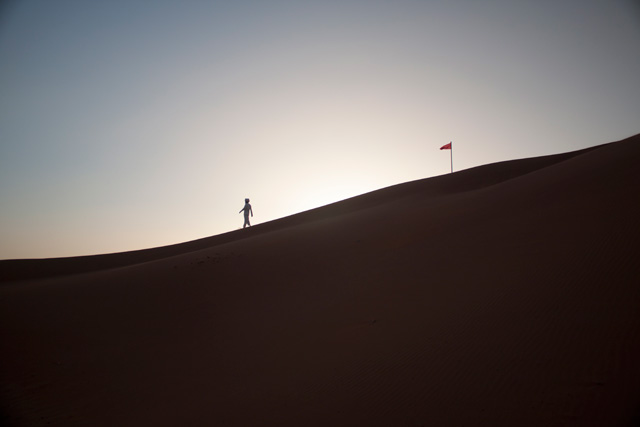
Nikhil Chopra. Use Like Water, 2013. Commissioned by the 12th Sharjah Biennale. Costume Design by Loise Braganza. Photograph: Istabraq Kinda. Image courtesy the artist, Chatterjee & Lal, Mumbai and GALLERIA CONTINUA, San Gimignano / Les Moulins / Beijing / Havana.
SAT: But it is almost as though the poetic is like an elastic band. Perhaps you stretch the limits of what it means?
NC: When you start to look at a painting, or a performance, and you give it time (or duration, which is very important to me), then you start to peel off the layers, and you start to understand and unravel process. There are the formal layers, but then also the contextual layers. This is maybe where the value of the work lies: in the process, not just in the painting, or drawing, or performance. This is why I give a lot of value to the act of making. I would never feel comfortable with a group of 10 young artists in my studio making work for me. I would be happy for someone to stretch the paper out for me, maybe, but I want to be the one that is making the drawing. I want to feel the dust fly off the paper as I press in the charcoal. I want that visceral, tactile relationship with my own work.
SAT: I guess what a relationship to poetry can do is keep the conversation from always being about power. Unfortunately, conversations about power can lead to dead ends. Or paranoid readings, as Eve Kosofsky Sedgwick wrote so eloquently. Does the poetic help you reach reparative, generative readings instead?
NC: I am very interested in the question of power, and a way to perhaps not reach the typical dead end is to think about the soft powers. And artists own these soft powers. As an artist, I feel that I am being put in an immensely powerful position. A large institution is listening to what I have to say and is allowing for an urgent question to surface, and even more importantly, allowing for the institutional space to be used as a critical space to have a strong, politically charged opinion, using the language of art-making and poetics. I am always paying close attention to the ways in which power plays out in my performances. It requires a lot of negotiation to even reach the position from which I can exercise this soft power. So, yes, while I understand what you mean about conversations reaching a dead end, I think it is important for us to see how we are complicit in the power structure, and always begin from there.
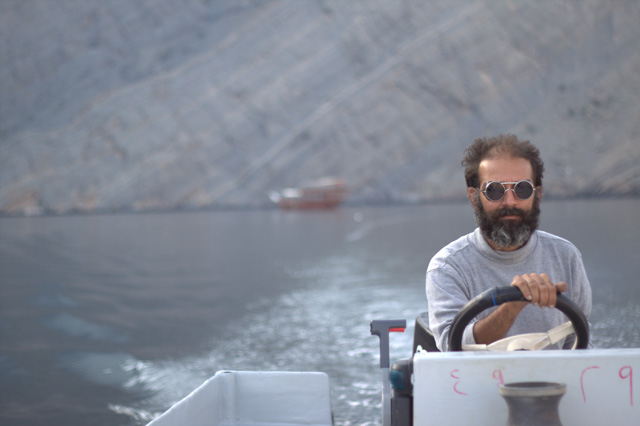
Nikhil Chopra. Use Like Water, 2013. Commissioned by the 12th Sharjah Biennale. Costume Design by Loise Braganza. Photograph: Istabraq Kinda. Image courtesy the artist, Chatterjee & Lal, Mumbai and GALLERIA CONTINUA, San Gimignano / Les Moulins / Beijing / Havana.
SAT: The word “soft” also implies that this power is amoebic, or porous somehow. You said that you would like art to be something that even lawyers can reference, and this touches on something important. The structures of knowledge that we have – such as the law or politics or science – often separate things into oppositions or binaries, where everything has a defining boundary. Perhaps being in a position of soft power means that you can interfere with those binaries. I certainly feel that as a writer, or in the way that I choose to read a work – like yours, for instance.
NC: Yes, totally! And I want to do this most of all with history. I am not a historian, and I don’t spend all of my time reading about history, but I am not interested in history from an enormously macro position. I can see so many histories all around me, especially in South Asia, and so I look at history intuitively and in the everyday. I am more interested in the micro histories, in the stories as opposed to the “histories”. I think this instinct comes from not wanting to give history a linearity, or not giving existing linear narratives any importance. I think chatting with a toothless aunt or grandmother is often far more fascinating than looking at a textbook historical narrative. It’s not just romantic: these are the history lessons that really stay with you.
• Nikhil Chopra is 2019-2020 artist in residence at the Metropolitan Museum of Art, New York. His live performance Lands, Waters and Skies will take place there each day from 12-20 September 2019.